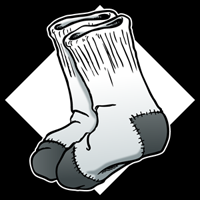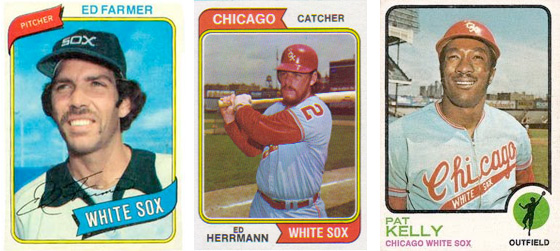| « Chicago 16-Inch Softball Hall of Fame Museum Opening This Weekend | Intelligentsia Cup Rides Through Chicago on July 26 » |
White Sox Wed Jul 16 2014
The White Sox's Unlikely All-Star All-Star Team
 Over the past week or so, Fox Sports 1 (at the convenient channel number 408!) has been airing classic MLB All-Star Game moments. Yesterday, they showed the 1999 game, which had some of the best players in baseball history: Tony Gwynn, Cal Ripken, Jr., Ken Griffey, Jr., Mark McGwire, Manny Ramirez, Mike Piazza, Randy Johnson, Mariano Rivera, and Pedro Martinez. The game was loaded.
Over the past week or so, Fox Sports 1 (at the convenient channel number 408!) has been airing classic MLB All-Star Game moments. Yesterday, they showed the 1999 game, which had some of the best players in baseball history: Tony Gwynn, Cal Ripken, Jr., Ken Griffey, Jr., Mark McGwire, Manny Ramirez, Mike Piazza, Randy Johnson, Mariano Rivera, and Pedro Martinez. The game was loaded.
However, like every All-Star game, there were some choices that I'm sure made sense at the time but look puzzling now. For instance, who was Jose Rosado? He played for parts of five seasons (three full seasons) and was the Royals' lone representative. Though he had a career 4.27 ERA, he made two All-Star games! Also in the 1999 game? Ron Coomer, Ed Sprague, Dave Nilsson and Kent Bottenfield.
This happens every year. Unknown players are selected for the All-Star Game because they had a good first half, or because their teams need a representative. It got me thinking, who were some of the more unlikely All-Star selections in White Sox history?
• Just last year, Jesse Crain had a career year while turning 32. Always a solid reliever but never a closer, Crain dominated for the Sox in 2013, with a 0.74 ERA and an 11.3 K/9. He then got hurt and hasn't played since June 29 of last year -- he missed the All-Star Game and didn't play with Tampa Bay after getting traded there.
• Esteban Loaiza was a middling pitcher for three teams over his first eight seasons in the majors. In 2003, though, Loaiza put together a legit Cy Young-caliber season. He had a 2.90 ERA and an AL-best 207 strikeouts in a career high 226.1 innings. He finished second to Roy Halladay in the Cy Young, but Loaiza started the 2003 All-Star Game at US Cellular Field. Pretty cool feat. He actually made the 2004 AS team too, but he was a little less deserving of that (4.77 ERA at the time of the game).
• From 1996 to 2000, James Baldwin was one of the key starting pitchers on the White Sox. In retrospect, it's a little unclear why: He had a combined 4.96 ERA and a below-average 95 ERA-plus. His win-loss record of 62-47 was pretty good, though, and that may have made him look better than he was (The Sox offense backed him up well). He was selected to the 2000 All-Star Game with a 4.28 first half ERA. His win-loss record, though, was 11-4.
• In his second year in the majors in 1994, Jason Bere rode a first half 3.56 ERA into a All-Star spot (He was also 9-2). A hard thrower, Bere experienced arm pain in 1995, underwent Tommy John surgery in 1996, and transformed into a below average journeyman starter for the rest of his career.
• Britt Burns had an OK baseball career, with a 3.66 ERA and 111 ERA-plus in eight years, all with the Sox. He was an all-star in 1981, with a 3.09 ERA in the first half. Interestingly enough, he was better in the second half of that year -- he had a 2.16 ERA, improved his strikeout-to-walk rate and let less runners reach base. This was all when Burns was 22, too.

• Before becoming the voice of the White Sox, Ed Farmer was a pitcher with eight teams, with modest results at every stop except one. He was good with the Sox -- 122 ERA-plus from 1979 to 1981, and he was an All-Star in 1980, racking up a career-high 30 saves that year.
• Over 11 seasons combined, catcher Ed Herrmann had a 5.9 WAR, with only two seasons with a WAR of 2.0 or better. The year 1974 was not one of them. Herrmann was an All-Star despite having only a .694 first half OPS. As a catcher, his caught stealing percentage of 40 percent that year wasn't bad, though.
• Speedy outfielder Pat Kelly had a good career, with 250 stolen bases over 15 seasons. He made the 1973 All-Star team in a year where he didn't have his best averaged-out stats, but it was his most complete seasons with career-highs in games played (144), hits (154) and total bases (191).
• Only once did catcher Duane Josephson play more than 100 games in a year, and when he did, he made the All-Star team. In 1968, Josephson hit .247 in his best big league season.
• Ray Herbert had an average MLB career, with a career 96 ERA-plus from 1950 to 1966. He posted a few good seasons towards the end of his career with the Sox and was an all-star in 1962. Herbert won 20 games and had a 3.27 ERA that year.
• Bob Keegan was great for the Sox in his first two seasons in the major leagues. In 1953 he had a 2.74 ERA while balancing starting and relieving, and in his lone all-star season of 1954, he had a 3.09 ERA and threw 14 complete games. Keegan was no young gun, though, as he was already 33 in '54. He played four more seasons before retiring.
• Randy Gumpert broke into the majors in 1936 as an 18-year-old rookie pitcher with the Philadelphia A's. After three seasons, though, Gumpert joined the military and did not play again until 1946. He was an all-star with the Sox in 1951, where in the first half of the season he won seven games and had a 3.36 ERA.
• It's almost like Thurman Tucker understood Sabermetrics decades before it even came to be. It was a different era, sure, but Tucker always walked more than he struck out and his walk totals stood out more than his lackluster power and speed numbers (9 career homers, 77 stolen bases). He was an All-Star in 1944, where he had a .395 OBP before the break.
• Lefty pitcher Thornton Lee was stellar in his only All-Star season of 1941, when he led the league in ERA (2.37), complete games (30), ERA-plus (174) and WHIP (1.165), all at the age of 34.
 • Catcher Luke Sewell played 20 seasons and had a combined 3.8 WAR. He was a decent hitter (lifetime .259 batting average) and Wikipedia says he was one of the best defensive catchers of his era. Sewell made his only All-Star team in 1937 at the age of 36, in his 17th season.
• Catcher Luke Sewell played 20 seasons and had a combined 3.8 WAR. He was a decent hitter (lifetime .259 batting average) and Wikipedia says he was one of the best defensive catchers of his era. Sewell made his only All-Star team in 1937 at the age of 36, in his 17th season.
• Monty Stratton had an extremely short career (parts of five seasons from 1934 to 1938, with only two seasons of pitching 20 or more games) but in 1937 he had a 2.40 ERA and a league-leading 1.087 WHIP. He was an all-star, too.








